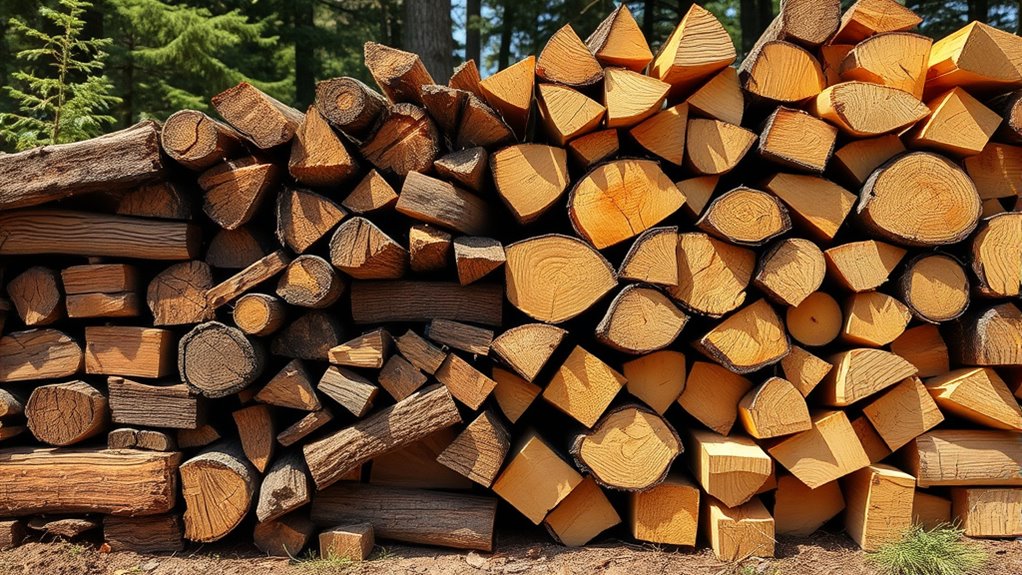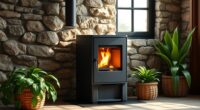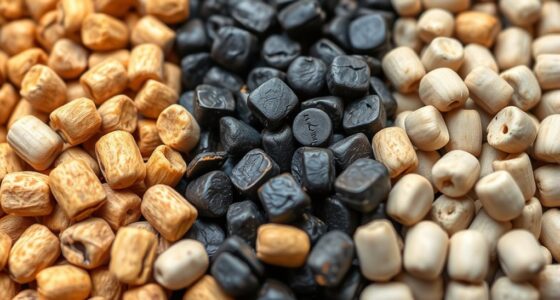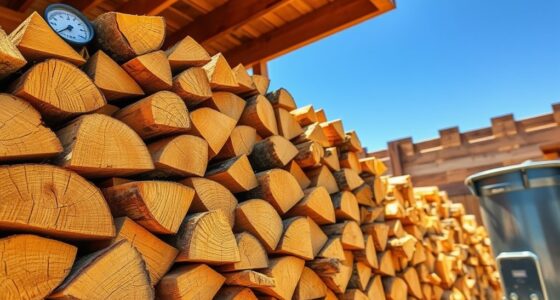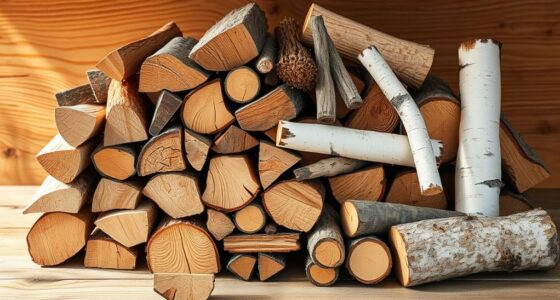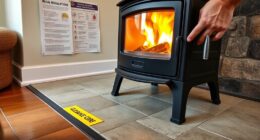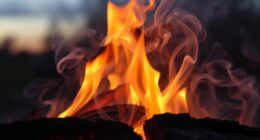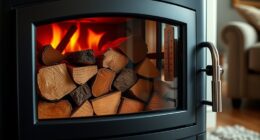For your stove, choose hardwoods like oak, maple, or ash, as they burn longer, produce more heat, and create less smoke, making them ideal for indoor fires. Softwoods like pine or fir ignite quickly and are great for starting fires, but burn faster and may cause creosote buildup. Proper seasoning and safe storage improve performance and safety. Want to maximize your stove’s efficiency? Keep going for expert tips on selecting, prepping, and burning the best wood.
Key Takeaways
- Hardwoods like oak and maple burn longer, produce more heat, and emit less smoke, making them ideal for indoor stoves.
- Softwoods such as pine ignite quickly and are suitable for starting fires but burn faster and produce more creosote.
- Seasoned hardwoods with low moisture content (under 25%) ensure efficient, cleaner burns and reduce chimney fire risks.
- Softwoods are better for quick, short-duration burns or outdoor fires due to their rapid ignition and burn rate.
- Proper storage and seasoning of firewood enhance safety, efficiency, and the quality of heat produced in your stove.
Characteristics and Differences of Hardwoods and Softwoods
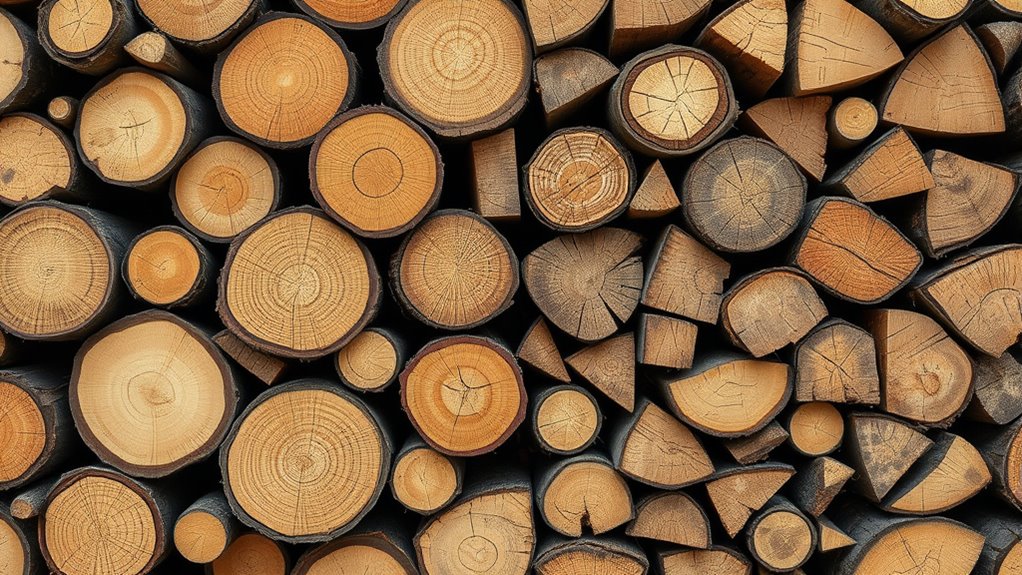
Hardwoods and softwoods differ primarily in their biological classification and physical properties, affecting how they burn in your stove. Hardwood, from deciduous trees, tends to be denser, which means it produces more heat—around 21.3 million BTUs per cord—and burns longer. Softwood, from conifers like pines, has lower wood density, providing fewer BTUs—about 15.4 million—and burns faster. When choosing firewood, seasoned wood is essential, as it burns cleaner and more efficiently. Hardwoods often have complex grain patterns, making them harder to split, but they ignite more steadily. Softwoods, with straighter grain and higher resin content, ignite easily but can lead to creosote buildup. Understanding these differences helps you select the right wood for your stove’s performance and safety. Additionally, using proper storage techniques ensures your firewood remains dry and ready for optimal burning efficiency.
Best Uses for Hardwood Firewood
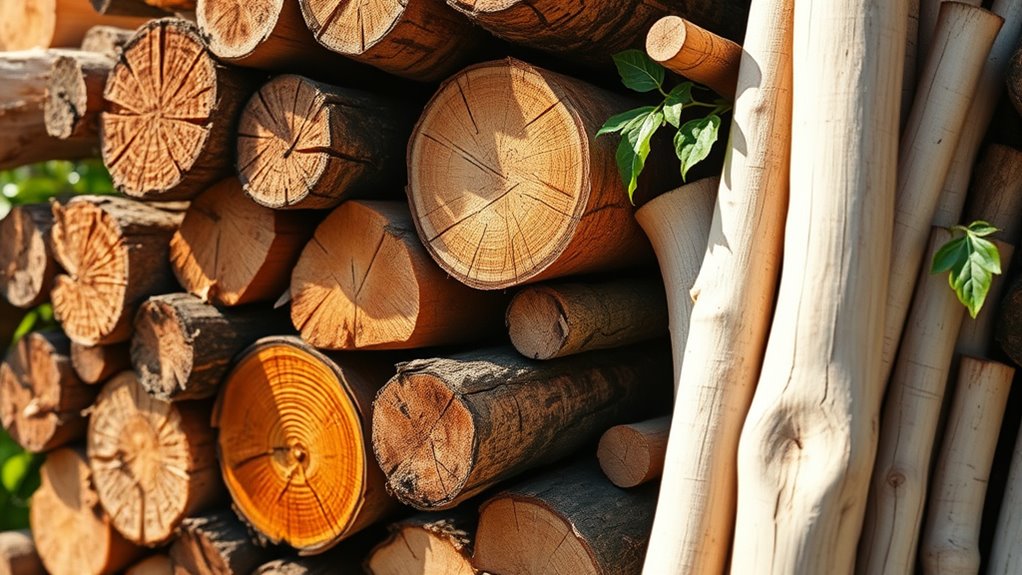
Hardwood firewood is perfect for indoor fires because it burns slowly and produces steady heat. Its high density means you get longer-lasting warmth with less frequent refueling. Plus, it emits less smoke, making your fireplace safer and cleaner. Additionally, choosing the right firewood type can improve the efficiency and safety of your heating setup. Historically, the use of dense, slow-burning woods like oak and hickory has been favored for their long-lasting combustion, contributing to efficient and consistent heating. Modern AI-driven insights can also help homeowners select the most suitable firewood for optimal performance.
Ideal for Indoor Fires
Have you ever noticed how fires made with hardwoods burn steadily and produce cozy warmth? Hardwood firewood, like oak, maple, and ash, is perfect for indoor fires because it burns longer and produces higher BTUs. When properly seasoned to 20-25% moisture, hardwoods ignite easily and generate less smoke and creosote, making your fireplace or wood stove cleaner and safer. Plus, hardwood fires tend to be quieter, with fewer pops and sparks, creating a more comfortable environment indoors. Use the table below to see how hardwoods excel in indoor settings:
| Feature | Benefit | Example Hardwood |
|---|---|---|
| Longer burn time | Consistent heat | Oak |
| Less smoke & creosote | Cleaner indoor combustion | Maple |
| Quiet burn | Cozy atmosphere | Ash |
| High BTUs | Efficient heating | Hickory |
| Properly seasoned | Safe, effective fires | All hardwoods |
Properly seasoned hardwoods reduce the risk of creosote buildup, which is crucial for maintaining a safe fireplace or stove. Additionally, selecting the right type of hardwood can enhance the overall efficiency of your heating setup, ensuring you stay warm all winter long.
Long-Lasting Heat Output
Because they burn slowly and steadily, hardwoods are your best choice when aiming for long-lasting heat output. Their dense structure allows them to burn longer, providing a sustained, consistent heat that keeps your home warm for hours. Hardwood firewood produces more BTUs—around 21.3 million per cord—delivering higher heat output compared to softwoods. Well-seasoned hardwoods like oak and hickory have low moisture content, which enhances efficiency and guarantees a more complete burn. This not only extends the duration of the fire but also reduces creosote buildup, making your stove safer and more reliable. Properly storing and seasoning hardwoods ensures optimal combustion and heat output, preventing moisture-related inefficiencies. Regularly checking for stove safety standards and ensuring proper installation can further improve safety and performance. Additionally, choosing properly stored and seasoned hardwoods optimizes combustion and heat output. With their higher energy content, hardwoods are ideal for winter heating, offering a dependable, long-lasting heat that minimizes the need for frequent refueling. Using hardwoods also reduces pollutant emissions, contributing to better air quality inside and outside your home.
Low Smoke Production
Are you looking to improve indoor air quality while heating your home? Using seasoned hardwoods like oak or ash guarantees a low smoke burn, which keeps your indoor fireplaces cleaner and healthier. Hardwoods produce less creosote buildup, reducing the risk of chimney fires and the need for frequent cleaning. When you choose seasoned hardwoods, you get a cleaner burn that emits fewer particulates and less visible smoke, making your heating more efficient. This not only benefits your indoor air quality but also extends the lifespan of your fireplace and chimney. For ideal results, always burn properly seasoned hardwoods, ensuring they’re dried well to achieve a true clean burn. Hardwood’s slow combustion maximizes heat while minimizing smoke, making it perfect for indoor fireplaces. Automation technologies are increasingly used in manufacturing to improve efficiency and safety, which can also contribute to cleaner and more consistent burns in heating appliances.
Best Uses for Softwood Firewood

Softwood firewood is best suited for quick-starting fires and outdoor activities, thanks to its fast ignition and high resin content. You’ll find softwood ideal for creating kindling and getting fires going quickly, especially in outdoor fires like campfires or fire pits. When properly seasoned, softwood ignites easily, making it perfect for fire starting without much effort. Keep in mind, its high resin levels can produce more smoke and creosote, so it’s best used outdoors rather than inside your fireplace. Softwoods like pine, spruce, and fir burn faster and provide short bursts of heat, which makes them perfect for casual fires or warming up on chilly evenings. Their lower density also means they’re easier to split and handle, enhancing your outdoor fire-making experience. Additionally, because softwood burns faster, it’s especially useful for quick heating needs or when you want to start a fire rapidly.
Impact of Wood Type on Burning Performance
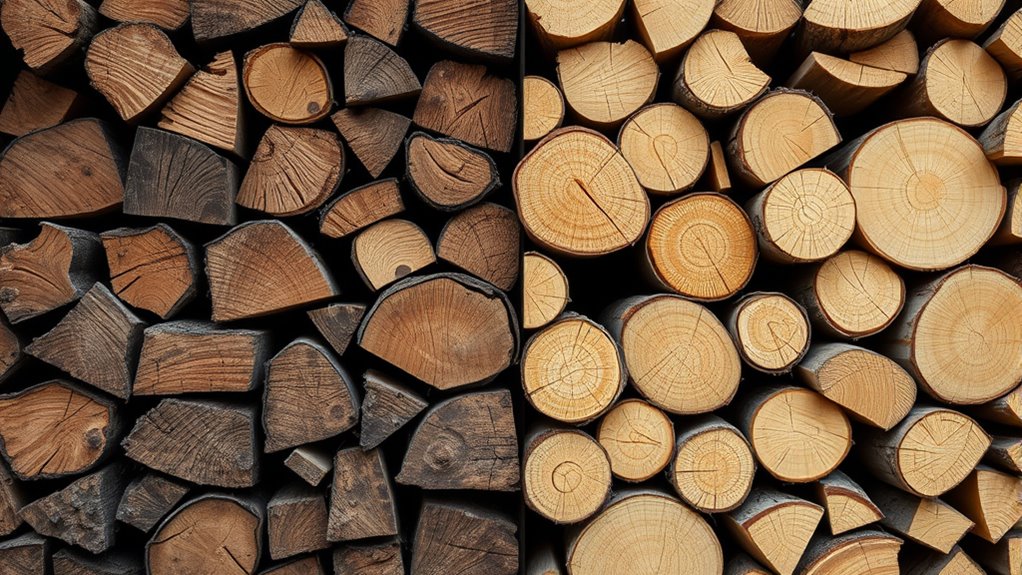
The type of wood you choose considerably affects how well your fire burns and how efficiently your stove performs. Hardwoods generally produce more heat per cord—around 21.3 million BTUs—because of their higher density, which results in a burn hotter and longer. Softwoods ignite quickly and burn faster due to their lower density and higher resin content, making them ideal for kindling but less efficient for sustained heating. proper seasoning of wood is essential to reduce moisture content and improve combustion efficiency. Wood seasoning involves allowing the wood to dry properly, which can take from six months to a year depending on climate and storage conditions. Dense hardwoods burn longer, with steady heat and less smoke. Softwoods ignite easily but produce more smoke and creosote. Dense hardwoods deliver more BTUs per cord for better warmth. Seasoned wood, regardless of type, burns cleaner and safer; proper seasoning is crucial for optimal combustion. Properly storing and seasoning your wood can significantly enhance combustion quality and reduce emissions wood storage practices.
Tips for Selecting and Preparing Firewood
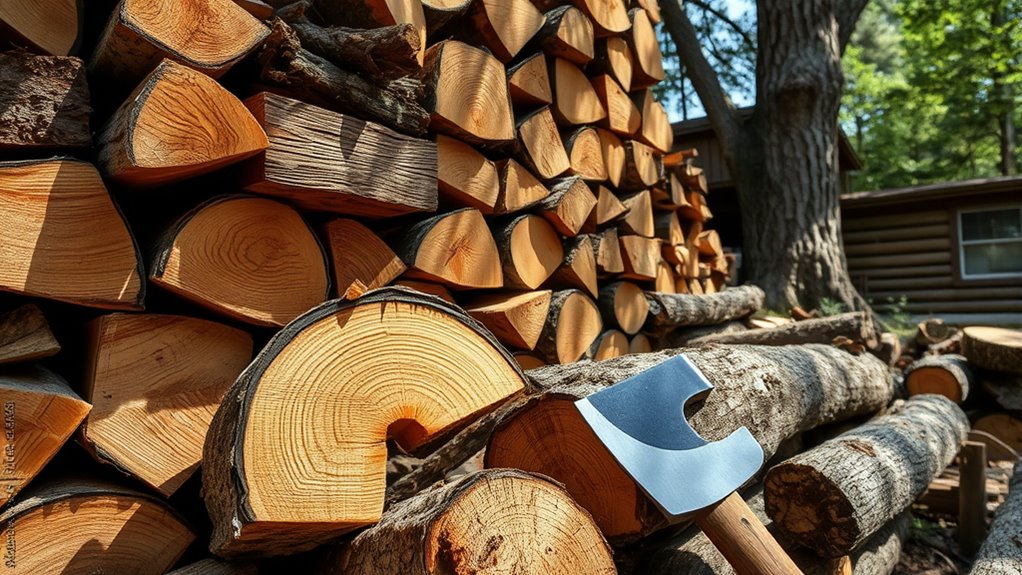
Choosing and preparing firewood properly guarantees a safer, more efficient fire. You’ll want to focus on seasoning logs, storing them correctly, and handling them safely. These tips help maximize burn time and minimize smoke while keeping your stove area safe. Additionally, understanding the digital literacy needs of seniors can enhance safety when managing firewood and using electronic tools for home maintenance. Recognizing the importance of fathers’ guidance can also inspire responsible firewood practices within the family setting. Being aware of pinball machine weight can assist in safely moving and installing firewood stacks, preventing injury or damage. Incorporating knowledge of shark behavior can also improve safety when collecting firewood in outdoor environments near water. Furthermore, understanding the artistic complexities of traditional and modern forms can inspire innovative approaches to organizing and storing your firewood efficiently.
Proper Seasoning Techniques
To guarantee your firewood burns efficiently and safely, properly seasoning your wood is essential. Proper seasoning reduces moisture content, ensuring your fire produces more heat and less smoke. The drying process takes 6-12 months, depending on wood type and storage conditions. To optimize proper seasoning:
- Stack your firewood in a dry, well-ventilated area off the ground
- Cover only the top, protecting from rain while allowing airflow on the sides
- Split logs into smaller pieces to speed up drying and promote even seasoning
- Use a moisture meter to check wood moisture; seasoned firewood should be below 25%
- For a more efficient burn, choose the appropriate hardwoods vs. softwoods, as they differ in burn time and heat output.
Avoid stacking directly against walls or under eaves, as these can trap moisture and hinder the drying process. Dry storage is key for safe, efficient burning.
Storage and Handling Tips
Proper storage and handling of firewood are crucial to guarantee it stays dry and ready for use. To prevent moisture absorption and pests, store your firewood off the ground on racks or pallets. Stacking logs properly allows for good airflow, which speeds up drying and reduces mold risk. Cover only the top of the stack to protect it from rain and snow while letting the sides breathe, aiding in proper seasoning. Regularly check the moisture content using a moisture meter or by knocking sticks together; a clear, sharp sound indicates the wood is well-seasoned and has a moisture content of 20-25%. Season your firewood for at least 6-12 months, depending on the type, to ensure it’s dry enough for efficient burning and safe handling. Incorporating positive thinking techniques into your routine can also help you approach firewood storage with patience and mindfulness. Additionally, using appropriate storage containers can further protect your firewood from environmental elements. Ensuring proper ventilation in your storage area is vital to maintaining optimal dryness and preventing mold growth.
Firewood Safety Measures
Ensuring your firewood is safe and effective for burning starts with selecting the right logs. Always choose well-seasoned firewood with a moisture content of 20-25%, which burns efficiently and reduces creosote buildup. Store your firewood in dry storage, off the ground, and covered only at the top, allowing the sides to breathe. Before burning, verify the wood is properly seasoned using a moisture meter or by performing the sound test—sharp sounds indicate dry wood. Avoid wet wood, green, or chemically treated options, as they produce excess smoke and pollutants, increasing chimney fire risks. Also, remove metal fasteners from reclaimed wood to prevent stove damage. Keeping these safety tips in mind helps you enjoy a safe, clean, and efficient fire.
Safety and Maintenance When Burning Different Types of Wood
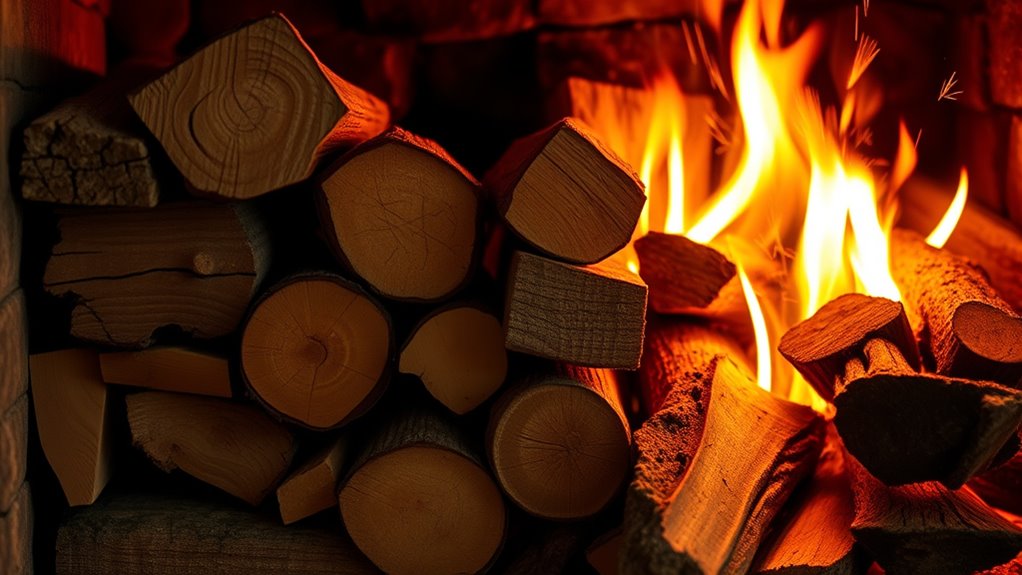
Burning different types of wood safely requires understanding how their properties affect your stove and chimney. Properly seasoned hardwood produces less creosote, reducing the risk of chimney fires, while unseasoned or green wood increases these hazards. Softwoods, with higher resin content, generate more creosote, so regular chimney inspections and cleaning are essential. Using safety equipment like chimney brushes and moisture meters helps prevent dangerous creosote buildup and guarantees safe operation. Never burn treated, stained, or painted wood, as these release toxic fumes and can damage stove components. Consistent maintenance, including chimney inspection and cleaning, is vital regardless of the wood type. Staying vigilant with these practices keeps your stove safe and extends its lifespan.
Frequently Asked Questions
Is Hardwood or Softwood Better for Wood-Burning Stove?
When choosing between hardwood and softwood for your stove, hardwoods are usually the better option. They produce more heat, burn longer, and create less creosote buildup, making your stove safer and more efficient. Softwoods ignite quickly and are easier to split, but they burn faster and can lead to more chimney maintenance. For ideal safety and heat output, you’ll want to prioritize hardwoods like oak or maple.
What Is the Best Wood to Burn in a Stove?
When choosing the best wood for your stove, opt for well-seasoned hardwoods like oak, maple, or hickory. They produce higher BTUs, burn longer, and create less creosote, ensuring safer, more efficient heating. Softwoods like pine are good for starting fires but burn faster and produce more resin. Using hardwoods regularly helps maintain a cleaner stove and chimney, providing consistent warmth and safety.
What Is the Most Efficient Type of Wood Burning Stove?
You might be surprised, but the most efficient wood-burning stove is one designed specifically for hardwoods. When you choose a stove optimized for seasoned hardwoods like oak or hickory, you maximize heat output and reduce creosote buildup. By pairing a high-efficiency stove with well-seasoned hardwood, you *uncover* longer burns, cleaner emissions, and more reliable warmth—making your heating system far more effective and environmentally friendly.
What Material Is Best for a Wood-Burning Stove?
You’re asking about the best material for your wood-burning stove. To get ideal performance, choose a stove made from durable, heat-resistant materials like cast iron or steel. These materials withstand high temperatures, distribute heat efficiently, and last longer. guarantee the stove has proper insulation and quality construction. Using the right material maximizes heat output, improves safety, and prolongs the stove’s lifespan, making your heating experience more effective and reliable.
Conclusion
Choosing the right wood is like tuning a musical instrument—you’ll get the perfect harmony of warmth and comfort. Hardwoods and softwoods each bring their own melody to your fire, shaping your cozy moments. By understanding their differences and preparing them well, you craft more than just heat—you craft memories. So, pick wisely, handle with care, and let your fire sing its warmest song through the dance of the woods.

